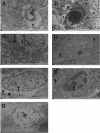Hypertonic/hyperoncotic solution attenuate blood-brain barrier breakdown and brain pathology in whole body hyperthermia rats
- PMID: 22140599
- PMCID: PMC3228583
Hypertonic/hyperoncotic solution attenuate blood-brain barrier breakdown and brain pathology in whole body hyperthermia rats
Abstract
This study was designed to investigate the effects of hypertonic/hyperoncotic solution on blood-brain barrier damage, brain edema and morphological changes of rats during whole body hyperthermia. 90 adult male Sprague-Dawley rats were randomized into 5 groups: Control group (a room temperature for 4 hours); Whole body hyperthermia group without solution treatment; Whole body hyperthermia group with Ringer's solution treatment; Whole body hyperthermia group with hydroxyethyl starch and Ringer's solution treatment; Whole body hyperthermia group with Hypertonic/hyperoncotic solution treatment. All rats except those of control group were housed in a heated container and maintained at 36°C for 3 hours until the rectal temperature reached 41-42°C. Corresponding solutions were administered intravenously at the beginning of whole body hyperthermia within 30 minutes as designed. Following whole body hyperthermia, rats were subsequently cooled down for 1h. Evans blue was administered intravenously when the rectal temperature was cooled down to 37°C. The leakage of Evans blue-albumin and water content of brain were calculated and morphological changes were investigated. In group with hypertonic/hyperoncotic solution treatment, brain water content and the leakage of Evans blue-albumin were the lowest among the four whole body hyperthermia groups. Compared with the other three whole body hyperthermia groups, in which profound to moderate damages to blood-brain barrier and brain tissue and cells were found, there were only slight morphological changes in the group with hypertonic/hyperoncotic solutionon treatment. Treatment with hypertonic/hyperoncotic solution appeared to attenuate the injury to blood-brain barrier and reduce brain edema and cell morphological changes in whole body hyperthermia rats.
Keywords: Whole body hyperthermia; blood-brain barrier; brain edema; brain morphological changes; hypertonic/hyperoncotic solution.
Figures




Similar articles
-
Hypertonic-hyperoncotic solutions improve cardiac function in children after open-heart surgery.Pediatrics. 2006 Jul;118(1):e76-84. doi: 10.1542/peds.2005-2795. Epub 2006 Jun 2. Pediatrics. 2006. PMID: 16751617 Clinical Trial.
-
[Effects of hypertonic sodium chloride hydroxyethyl starch 40 on brain histopathology in rats with whole body hyperthermia].Nan Fang Yi Ke Da Xue Xue Bao. 2011 Dec;31(12):2067-71. Nan Fang Yi Ke Da Xue Xue Bao. 2011. PMID: 22200714 Chinese.
-
[Reproduction of a murine model of hyperthermic treatment].Zhongguo Wei Zhong Bing Ji Jiu Yi Xue. 2009 Jan;21(1):51-4. Zhongguo Wei Zhong Bing Ji Jiu Yi Xue. 2009. PMID: 19141194 Chinese.
-
[Hypertonic solutions and intracranial pressure].Schweiz Med Wochenschr. 1996 Sep 28;126(39):1635-43. Schweiz Med Wochenschr. 1996. PMID: 8927967 Review. French.
-
[Hypertonic-hyperoncotic solutions: possibilities and limits].Praxis (Bern 1994). 1998 May 13;87(20):683-9. Praxis (Bern 1994). 1998. PMID: 9633225 Review. German.
Cited by
-
Influence of Tai Chi exercise cycle on the senile respiratory and cardiovascular circulatory function.Int J Clin Exp Med. 2014 Mar 15;7(3):770-4. eCollection 2014. Int J Clin Exp Med. 2014. PMID: 24753776 Free PMC article.
References
-
- Hall DM, Baumgardner KR, Oberley TD, Gisolfi CV. Splanchnic tissues undergo hypoxic stress during whole body hyperthermia. Am J Physiol. 1999;276:G1195–G1203. - PubMed
-
- Kerner T, Deja M, Ahlers O, Hildebrandt B, Dieing A, Riess H, Wust P, Gerlach H. Monitoring arterial blood pressure during whole body hyperthermia. Acta Anaesthesiol Scand. 2002;46:561–566. - PubMed
-
- Youtan Liu, Shaonong Huang, Zhicong Chen, Feiyan Zhong, Jianfang Lu, Jianyan Chen, Yonghui Zheng. Hemodynamic changes during veno-venous perfusion-induced systemic hyperthermia in patients with advanced malignant tumor. Bulletin of The Academy of Military Medical Sciences. 2004;28:160–162.
-
- Rozet I, Tontisirin N, Muangman S, Vavilala MS, Souter MJ, Lee LA, Kincaid MS, Britz GW, Lam AM. Effect of Equiosmolar Solutions of Mannitol versus Hypertonic Saline on Intraoperative Brain Relaxation and Electrolyte Balance. Anesthesiology. 2007;107:697–704. - PubMed
-
- Noppens RR, Christ M, Brambrink AM, Koerner IP, Heimann A, Kempski O. An early bolus of hypertonic saline hydroxyethylstarch improves long-term outcome after global cerebral ischemia. Crit Care Med. 2006;34:2194–2200. - PubMed
LinkOut - more resources
Full Text Sources
